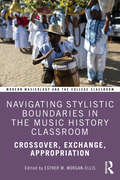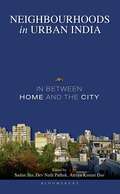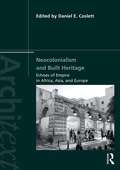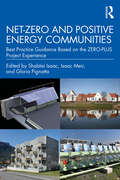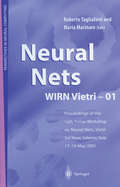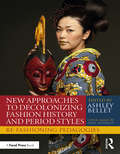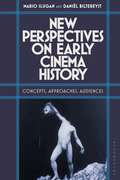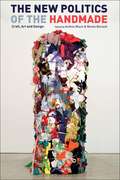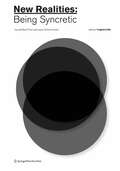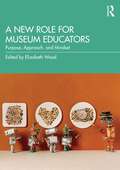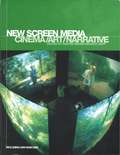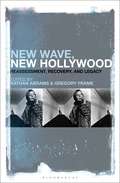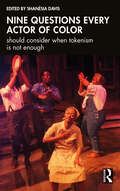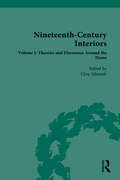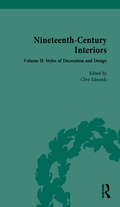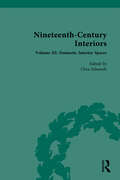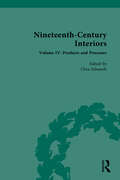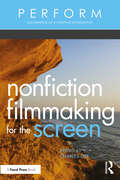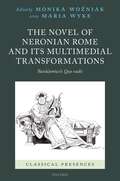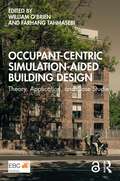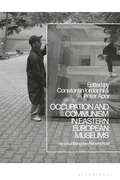- Table View
- List View
Navigating Stylistic Boundaries in the Music History Classroom: Crossover, Exchange, Appropriation (Modern Musicology and the College Classroom)
At a time of transformation in the music history classroom and amid increasing calls to teach a global music history, Navigating Stylistic Boundaries in the Music History Classroom adds nuance to the teaching of varied musical traditions by examining the places where they intersect and the issues of musical exchange and appropriation that these intersections raise. Troubling traditional boundaries of genre and style, this collection of essays helps instructors to denaturalize the framework of Western art music and invite students to engage with other traditions—vernacular, popular, and non-Western—on their own terms.The book draws together contributions by a wide range of active scholars and educators to investigate the teaching of music history around cases of stylistic borders, exploring the places where different practices of music and values intersect. Each chapter in this collection considers a specific case in which an artist or community engages in what might be termed musical crossover, exchange, or appropriation and delves deeper into these concepts to explore questions of how musical meaning changes in moving across worlds of practice. Addressing works that are already widely taught but presenting new ways to understand and interpret them, this volume enables instructors to enrich the perspectives on music history that they present and to take on the challenge of teaching a more global music history without flattening the differences between traditions.
Neighbourhoods in Urban India: In Between Home and the City
'…a brilliant exploration of urbanism between the concept city and the lived city.… The volume focuses on urban life lived between home and the world, institutions and experiences, representations and affects…. Its fascinating range of empirically rich and analytically sophisticated excavations of neighbourhoods make the volume a must-have in the bookshelf on South Asian urban studies.' -Gyan Prakash, Princeton University'A must-read for those who wish to study the micro aspects of contemporary urbanity.' -Sujata Patel, Savitribai Phule Pune University'This book is a powerful addition to the study of Indian urbanism.' -Ravi Sundaram, Centre for the Study of Developing Societies (CSDS)In the last couple of decades, the global South, in general, and India, in particular, have witnessed a massive growth of cities. In India, more than one-third of its population lives in cities. However, urban development, growth and expansion are not merely about infrastructures and enlargement of cityscapes. This edited volume focuses on neighbourhoods, their particularities and their role in shaping our understanding of the urban in India. It locates Indian experiences in the larger context of the global South and seeks to decentre the dominant Euro-American discourse of urban social life.Neighbourhoods in Urban India: In Between Home and the City offers an understanding of neighbourhoods as changing socio-spatial units in their specific regional settings by underlining the way value regimes (religiosity and subjectivities) give neighbourhoods their social meanings and stereotypes. It unpacks discourses and knowledge practices, such as planning, architecture and urban discourses of governance. It further discloses the linkages and disjunctures between the social practices of neighbourhoods and the language, logic and experiences of dwelling, housing, urban planning and governance, and focuses on the particularities and heterogeneities of neighbourhoods and neighbourliness.
Neocolonialism and Built Heritage: Echoes of Empire in Africa, Asia, and Europe (Architext)
Architectural relics of nineteenth and twentieth-century colonialism dot cityscapes throughout our globalizing world, just as built traces of colonialism remain embedded within the urban fabric of many European capitals. Neocolonialism and Built Heritage addresses the sustained presence and influence of historic built environments and processes inherited from colonialism within the contemporary lives of cities in Africa, Asia, and Europe. Novel in their focused consideration of ways in which these built environments reinforce neocolonialist connections among former colonies and colonizers, states and international organizations, the volume’s case studies engage highly relevant issues such as historic preservation, heritage management, tourism, toponymy, and cultural imperialism. Interrogating the life of the past in the present, authors thus challenge readers to consider the roles played by a diversity of historic built environments in the ongoing asymmetrical balance of power and unequal distribution capital around the globe. They present buildings’ maintenance, management, reuse, and (re)interpretation, and in so doing they raise important questions, the ramifications of which transcend the specifics of the individual sites and architectural histories they present.
Neocolonialism and Built Heritage: Echoes of Empire in Africa, Asia, and Europe (Architext)
Architectural relics of nineteenth and twentieth-century colonialism dot cityscapes throughout our globalizing world, just as built traces of colonialism remain embedded within the urban fabric of many European capitals. Neocolonialism and Built Heritage addresses the sustained presence and influence of historic built environments and processes inherited from colonialism within the contemporary lives of cities in Africa, Asia, and Europe. Novel in their focused consideration of ways in which these built environments reinforce neocolonialist connections among former colonies and colonizers, states and international organizations, the volume’s case studies engage highly relevant issues such as historic preservation, heritage management, tourism, toponymy, and cultural imperialism. Interrogating the life of the past in the present, authors thus challenge readers to consider the roles played by a diversity of historic built environments in the ongoing asymmetrical balance of power and unequal distribution capital around the globe. They present buildings’ maintenance, management, reuse, and (re)interpretation, and in so doing they raise important questions, the ramifications of which transcend the specifics of the individual sites and architectural histories they present.
Net-Zero and Positive Energy Communities: Best Practice Guidance Based on the ZERO-PLUS Project Experience
This book presents a methodology for the design, construction, monitoring, optimization, and post-occupancy evaluation of net-zero and positive-energy communities based on the experiences gained in the EU Horizon 2020 ZERO-PLUS project. It describes the steps, tools, and methods developed during the project, providing practical information for the energy and construction sector that will be of interest to students, engineers, architects, developers, and professionals working around high performance architecture and sustainable communities. Through the ZERO-PLUS project, a consortium of 32 partners from eight countries, including academic institutions, technology providers, architects, and construction companies, designed four communities covering completely different geo-climatic regions, construction practices, and cultural backgrounds in Cyprus, Italy, France, and the UK. The communities were designed, optimized, constructed, monitored, handed over to tenants, post-occupancy evaluated, and troubleshooted through a system of continuous collaboration and data acquisition. This book presents these case studies and shows how the project targets of reducing electricity consumption below 20 kWh/m2/y, increasing electricity production from Renewable Energy Systems to over 50 kWh/m2/y, and at cheaper costs when compared to current zero-energy buildings were reached and surpassed. These cases demonstrate that a holistic and interactive approach to design and construction can bring communities a high standard of sustainability. The key features of the book include: • Practical guidance drawn from the interdisciplinary, international, and remote cooperation between experts from academia and industry across the construction sector. • A survey of the state-of-the-art on net-zero and positive-energy communities, including the experience and the lessons learned from previous projects and from the ZERO-PLUS project. • Descriptions of novel emerging renewable energy technologies, integrated into real case study communities to achieve the energy generation target of the communities. • A comprehensive set of approaches, tools, guidelines, best practices, challenges, and lessons learned from the five-year ZERO-PLUS project and the completion of four residential case studies to inform the reader of how to achieve affordable net-zero energy communities. • Four typologies of residential communities located in different climatic conditions are presented, touching on the critical aspects of the design, construction, monitoring, and occupancy phase • A discussion of future trends for developing communities that are more liveable, accessible, and sustainable and which can comply with new energy policies in a way that is affordable for the owners and residents.
Neural Nets WIRN Vietri-01: Proceedings of the 12th Italian Workshop on Neural Nets, Vietri sul Mare, Salerno, Italy, 17–19 May 2001 (Perspectives in Neural Computing)
This volume contains the proceedings of the 12th Italian Workshop on Neural Nets WIRN VIETRI-Ol, jointly organized by the International Institute for Advanced Scientific Studies "Eduardo R. Caianiello" (IIASS), the Societa Italiana Reti Neuroniche (SIREN), the IEEE NNC Italian RIG and the Italian SIG of the INNS. Following the tradition of previous years, we invited three foreign scientists to the workshop, Dr. G. Indiveri and Professors A. Roy and R. Sun, who respectively presented the lectures "Computation in Neuromorphic Analog VLSI Systems", "On Connectionism and Rule Extraction", "Beyond Simple Rule Extraction: Acquiring Planning Knowledge from Neural Networks" (the last two papers being part of the special session mentioned below). In addition, a review talk was presented, dealing with a very up-to-date topic: "NeuroJuzzy Approximator based on Mamdani's Model". A large part of the book contains original contributions approved by referees as oral or poster presentations, which have been assembled for reading convenience into three sections: Architectures and Algorithms, Image and Signal Processing, and Applications. The last part of the books contains the papers of the special Session "From Synapses to Rules". Our thanks go to Prof. B. Apolloni, who organized this section. Furthermore, two sections are dedicated to the memory of two great scientists who were friends in life, Professors Mark Aizerman and Eduardo R. Caianiello. The editors would like to thank the invited speakers, the review lecturers and all the contributors whose highly qualified papers helped with the success of the workshop.
New Approaches to Decolonizing Fashion History and Period Styles: Re-Fashioning Pedagogies
New Approaches to Decolonizing Fashion History and Period Styles: Re-Fashioning Pedagogies offers a wide array of inclusive, global, practical approaches for teaching costume and fashion history.Costume designers, technicians, and historians have spent the last several years re-evaluating how they teach costume and fashion history, acknowledging the need to refocus the discourse to include a more global perspective. This book is a collection of pedagogical methods aimed to do just that, with an emphasis on easy reference, accessible activities, and rubrics, and containing a variety of ways to restructure the course. Each chapter offers a course description, syllabus calendar, course objectives, and learning outcomes, as well as sample activities from instructors across the country who have made major changes to their coursework. Using a combination of personal narratives, examples from their work, bibliographies of helpful texts, and student responses, contributors suggest a variety of ways to decolonize the traditionally Western-focused fashion history syllabus.This collection of pedagogical approaches is intended to support and inspire instructors teaching costume design, costume history, fashion history, period styles, and other aesthetic histories in the arts.
New Perspectives on Early Cinema History: Concepts, Approaches, Audiences
In this book, editors Mario Slugan and Daniël Biltereyst present a theoretical reconceptualization of early cinema. To do so, they highlight the latest methods and tools for analysis, and cast new light on the experience of early cinema through the application of these concepts and methods.The international host of contributors evaluate examples of early cinema across the globe, including The May Irwin Kiss (1896), Un homme de têtes (1900), The Terrible Turkish Executioner (1904) and Tom Tom the Piper's Son (1905). In doing so, they address the periodization of the era, emphasizing the recent boon in the availability of primary materials, the rise of digital technologies, the developments in new cinema history, and the persistence of some conceptualizations as key incentives for rethinking early cinema in theoretical and methodological terms. They go on to highlight cutting-edge approaches to the study of early cinema, including the use of the Mediathread Platform, the formation of new datasets with the help of digital technologies, and exploring the early era in non-western cultures. Finally, the contributors revisit early cinema audiences and exhibition contexts by investigating some of the earliest screenings in Denmark and the US, exploring the details of black cinema going in Harlem, and examining exhibition practices in Germany.
The New Politics of the Handmade: Craft, Art and Design
Contemporary craft, art and design are inseparable from the flows of production and consumption under global capitalism. The New Politics of the Handmade features twenty-three voices who critically rethink the handmade in this dramatically shifting economy. The authors examine craft within the conditions of extreme material and economic disparity; a renewed focus on labour and materiality in contemporary art and museums; the political dimensions of craftivism, neoliberalism, and state power; efforts toward urban renewal and sustainability; the use of digital technologies; and craft's connections to race, cultural identity and sovereignty in texts that criss-cross five continents. They claim contemporary craft as a dynamic critical position for understanding the most immediate political and aesthetic issues of our time.
New Realities: IXth Consciousness Reframed Conference Vienna 2008 (Edition Angewandte)
7 Gerald Bast 8 Roy Ascott 10 Round Table Contents 22 Roy Ascott 190 David McConville 26 Elif Ayiter 194 Francesco Monico 30 John Backwell/John Wood 199 Max Moswitzer 34 René Bauer/Beat Suter 202 Sana Murrani 38 Laura Beloff 207 Ryohei Nakatsu 42 Martha Blassnigg 211 Martha Patricia Niño Mojica 46 Ingrid Böck 215 Carlos Nóbrega 51 Wulf Walter Böttger 220 Robert Pepperell 56 Pier Luigi Capucci 224 Michael Punt 60 Simona Caraceni 228 Susanne Ramsenthaler 65 Antonio Caronia 232 Barbara Rauch 69 Linda Cassens Stoian 236 Nicolas Reeves 73 Isabelle Choinière 240 Clarissa Ribeiro/Gilbertto Prado 78 David Crawford 245 Ana Rosa Richardson 82 Nina Czegledy 248 Glauce Rocha de Oliveira 86 Margaret Dolinsky 253 Natacha Roussel 90 Hannah Drayson 257 Semi Ryu 94 Alan Dunning/Paul Woodrow 261 Miguel Santos 98 Ernest Edmonds 266 Jinsil Seo/Diane Gromala 102 Jürgen Faust 271 Christa Sommerer/Laurent Mignonneau/ 106 Wolfgang Fiel Michael Shamiyeh 110 Andreas Leo Findeisen 276 René Stettler 114 Karmen Franinovic 280 Randall Teal 118 Gonçalo Miguel Furtado 284 Federica Timeto Cardoso Lopes 288 Naoko Tosa/Seigo Matsuoka 123 Martha Carrer Cruz Gabriel 292 Sarah Tremlett 127 Gregory P. Garvey 297 Nicholas Tresilian 132 Luis Miguel Girão 301 Suzete Venturelli/Mario Maciel/ 136 Tina Gonsalves Johnny Souza 140 Jochen Hoog/Manfred Wolff-Plottegg 306 Natasha Vita-More 144 Birgit Huemer 310 Monika Weiss 148 Jung A.
A New Role for Museum Educators: Purpose, Approach, and Mindset
A New Role for Museum Educators shows how learning happens in communities, how volunteers and professionals approach their work, the underlying principles and philosophies that guide the work of museum education, and how these practices are always evolving to remain relevant. Museum education in its most expansive definition is about communicating messages, creating learning experiences, and, at its most aspirational, promoting human development for people of all backgrounds, abilities, and circumstances. This edited volume revisits the legacy of museum education practices, reflecting on the changing context of community and the role of cultural institutions, and provides insights into new directions that museums can take with a visitor-centered mindset. It provides foundational concepts around educational philosophies that guide practice, applied methods and approaches for implementation, and the ethos of an educational institution intended to support community learning and engagement that are essential to provide for the wide-ranging needs of all audiences. International perspectives from a variety of museums are considered, including art museums, children’s museums, history museums and historic sites, science museums, botanical gardens, zoos, and aquariums. Chapters include thought-provoking reflections on contemporary practices, concrete examples from across the globe, and useful tools for anyone working with public audiences. Grounded in practice and informed by research, this volume will be a go-to resource for arts and cultural organization practitioners, particularly those working in Museum Education. It will also be essential reading for students of Museum Studies, Education, and related fields
New Screen Media: Cinema/Art/Narrative
This text presents the work of cultural theorists and philosophers of new media, together with the perspectives of artists experimenting with different interactive models critically examining their own practice. The book proposes the use of new critical tools for discussing new media forms.
New Wave, New Hollywood: Reassessment, Recovery, and Legacy
As a period of film history, The American New Wave (ordinarily understood as beginning in 1967 and ending in 1980) remains a preoccupation for scholars and audiences alike. In traditional accounts, it is considered to be bookended by two periods of conservatism, and viewed as a (brief) period of explosive creativity within the Hollywood system. From Bonnie and Clyde to Heaven's Gate, it produced films that continue to be watched, discussed, analysed and poured over.It has, however, also become rigidly defined as a cinema of director-auteurs who made a number of aesthetically and politically significant films. This has led to marginalization and exclusion of many important artists and filmmakers, as well as a temporal rigidity about what and who is considered part of the 'New Wave proper'. This collection seeks to reinvigorate debate around this area of film history. It also looks in part to demonstrate the legacy of aesthetic experimentation and political radicalism after 1980 as part of the 'legacy' of the New Wave. Thanks to important new work that questions received scholarly wisdom, reveals previously marginalised filmmakers (and the films they made), considers new genres, personnel, and films under the banner of 'New Wave, New Hollywood', and reevaluates the traditional approaches and perspectives on the films that have enjoyed most critical attention, New Wave, New Hollywood: Reassessment, Recovery, Legacy looks to begin a new discussion about Hollywood cinema after 1967.
NFTs, Creativity and the Law: Within and Beyond Copyright (Routledge Research in the Creative and Cultural Industries)
Non-Fungible Tokens (NFTs) have emerged as an important medium for the creation, sale and collection of art, with many major business and fashion houses creating their own NFT projects. This book investigates the eruption of NFT crypto art, and its impact on copyright law.Chapters address topics at the intersection between AI, smart contracts, data science, copyright law and arts administration. With snapshots of the ongoing heated debates around copyright law, the book investigates whether NFTs violate copyright and moral rights, the liability of NFTs platforms, impacts on ethical issues such as counterfeiting. The first book published on this emergent topic, this book offers a comprehensive overview of opportunities and challenges raised by NFTs to copyright law and, more generally, to the regulation and economics of the creative and cultural industries.The book is addressed to law and tech enthusiasts as well as academics, students, practitioners and policy makers interested in the intersection between copyright rules and new forms of technology.
Nine questions every actor of color should consider when tokenism is not enough
This book confronts and analyzes the systemic racism that confronts actors of color in the USA through interviews with leading performers in the nation’s theatrical epicentre of Chicago.Each chapter deals with a different central question, from how these actors approach roles and the obstacles that they face, to the ways in which the industry can change to better enable actors of color. By bringing together these actors and sharing the ways in which they have functioned within the white theatre world, we can appreciate how theatre needs to embrace their identities so that all voices are heard, understood, and valued. The stories of these actors will reflect the systemic racism of the past and present with the hope of remaking the future.This is an important book for students, teachers, and professionals who engage in theatre work, helping them to understand the lived experiences of actors of color through those actors’ own words.
Nineteenth-Century Interiors: Volume I: Theories and Discourses Around the Home
This volume of primary source materials documents the nature of the home and the theories and discussions around the concept. It examines the class divisions that become evident with the ostentatious lifestyles of political and society hostesses at the peak, whilst middle-class housing often in suburbia, seemed to have created a separation of home and work, arguably suggesting men and women lived in separate spheres. Working-class interiors, often seen the eyes of middle-class observers, were at the bottom of the hierarchy and often reflected concerns of social inequality and misery. The documents also address the process of purchasing and decorating a home, advice on decoration and home management, the nature of taste and comfort, and the symbolic roles of the home as an anchor in society. Accompanied by extensive editorial commentary, this collection will be of great interest to students and scholars of art history.
Nineteenth-Century Interiors: Volume II: Styles of Decoration and Design
This volume of primary source materials documents the nineteenth-century search for a representative style, and the alternating fashions for interiors that demonstrated the consumerism of the period. Although in some senses every interior is unique so that a style canon may seem to be meaningless, there have been important historical trends or styles that have influenced individual interiors, and these have formed the groundwork from which other styles and tastes have developed and changed. Accompanied by extensive editorial commentary, this collection will be of great interest to students and scholars of art history.
Nineteenth-Century Interiors: Volume III: Domestic Interior Spaces
This volume of primary source materials documents the spatial layouts of the nineteenth century home as they often became more precisely planned with rooms for specific purposes being developed. The styles began to truly reflect the owner’s taste and position. The range is of course vast from single room dwellings to large-scale mansions and numerous variations in-between. Accompanied by extensive editorial commentary, this collection will be of great interest to students and scholars of art history.
Nineteenth-Century Interiors: Volume IV: Products and Processes
This volume of primary source materials documents the essential practical aspects of making a home, decorating it and then furnishing it. The crucial constitutive parts that make up an interior from floor to ceiling are considered here in detail. The role of advice books and articles that attempted to direct homemakers in particular directions are examined, as are the more practical how-to publications that demonstrated the processes of interior decoration. Accompanied by extensive editorial commentary, this collection will be of great interest to students and scholars of art history.
Nonfiction Filmmaking for the Screen (PERFORM)
Combining essays and interviews with nonfiction filmmakers, this collection explores the business side of nonfiction media creation for film and television. Over 30 industry professionals dispel myths about the industry and provide practical advice on topics such as how to break into the field; how to develop, nurture, and navigate business relationships; and how to do creative work under pressure. Readers will also learn about the entrepreneurial expectations in relation to marketing, strategies for contending with the emotional highs and lows of creating nonfiction media, and money management whilst pursuing a career in creating nonfiction media. Written for undergraduates and graduates studying filmmaking, media production, and documentary filmmaking, as well as aspiring nonfiction media creators and documentary filmmakers, this book provides readers with a wealth of first-hand information that will help them create their own opportunities and pursue a career in nonfiction film and television.
Nosferatu in the 21st Century: A Critical Study
‘Nosferatu’ in the 21st Century is a celebration and a critical study of F. W. Murnau’s seminal vampire film Nosferatu, eine Symphonie des Grauens on the 100th anniversary of its release in 1922. The movie remains a dark mirror to the troubled world we live in seeing it as striking and important in the 2020s as it was a century ago. The unmistakable image of Count Orlok has traveled from his dilapidated castle in old world Transylvania into the futuristic depths of outerspace in Star Trek and beyond as the all-consuming shadow of the vampire spreads ever wider throughout contemporary popular culture. This innovative collection of essays, with a foreword by renowned Dracula expert Gary D. Rhodes, brings together experts in the field alongside creative artists to explore the ongoing impact of Murnau’s groundbreaking movie as it has been adapted, reinterpreted, and recreated across multiple mediums from theatre, performance and film, to gaming, music and even drag. As such, ‘Nosferatu’ in the 21st Century is not only a timely and essential book about Murnau’s film but also illuminates the times that produced it and the world it continues to influence.
The Novel of Neronian Rome and its Multimedial Transformations: Sienkiewicz's Quo vadis (Classical Presences)
The Polish writer Henryk Sienkiewicz was awarded the Nobel Prize for literature in 1905 largely on the basis of his historical novel Quo vadis: A Narrative of the Time of Nero. The novel's vivid and moving reconstruction of religious persecution and struggle against tyranny catapulted its author into literary stardom. But, before long, Quo vadis began to 'detach' itself from the person of its author and to become a multimedial, mass culture phenomenon. In the West and in the East, it was adapted for stage and screen, provided the inspiration for works of music and other genres of literature, was transformed into comic strips and illustrated children's books, was cited in advertising, and referenced in everyday objects of material culture. This volume explores the strategies Sienkiewicz used to recreate Neronian Rome and the reasons his novel was so avidly consumed and reproduced in new editions, translations, visual illustrations, and adaptations to the stage and screen across Europe and in the United States. The contributions render visible for English-speaking readers the impact of a Polish work of high literature on the presence of Nero, Christian persecution, and ancient Rome in Western popular culture.
Occupant-Centric Simulation-Aided Building Design: Theory, Application, and Case Studies
Occupant-Centric Simulation-Aided Building Design promotes occupants as a focal point for the design process. This resource for established and emerging building designers and researchers provides theoretical and practical means to restore occupants and their needs to the heart of the design process. Helmed by leaders of the International Energy Agency Annex 79, this edited volume features contributions from a multi-disciplinary, globally recognized team of scholars and practitioners. Chapters on the indoor environment and human factors introduce the principles of occupant-centric design while chapters on selecting and applying models provide a thorough grounding in simulation-aided building design practice. A final chapter assembling detailed case studies puts the lessons of the preceding chapters into real-world context. In fulfillment of the International Energy Agency’s mission of disseminating research on secure and sustainable energy to all, Occupant-Centric Simulation-Aided Building Design is available as an Open Access Gold title. With a balance of fundamentals and design process guidelines, Occupant-Centric Simulation-Aided Building Design reorients the building design community toward buildings that recognize and serve diverse occupant needs, while aiming for superior environmental performance, based on the latest science and methods.
Occupation and Communism in Eastern European Museums: Re-Visualizing the Recent Past
This volume offers fresh perspectives on the representation of the recent past in museums of the Second World War and of communism in post-communist Eastern Europe. It does so against the background of recent European-wide debates on history, memory and politics. The contributors from across Europe focus comparatively on a wide variety of case studies, pointing out similarities and differences, and accounting for transnational patterns of remembrance at regional and European level. Occupation and Communism in Eastern European Museums argues that museums have a huge influence on the image of the communist past in Eastern Europe. It shows how they use a vast array of media tools, visual tactics and commercial strategies in order to substantiate ideological approaches to the past and to shape the attitude of public opinion.
Öffentliche Kunst, Kunst im öffentlichen Raum Niederösterreich, Band 8: / Public Art Lower Austria, Volume 8 (Veröffentlichte Kunst. Kunst im öffentlichen Raum Niederösterreich Public Art Lower Austria #8)
Kunst im öffentlichen Raum in Niederösterreich ist ein einzigartiges Modell, das international höchste Anerkennung findet. Die im ländlichen und kleinstädtischen Raum entstandenen Projekte bedeutender, aber auch junger unbekannter KünstlerInnen setzen sich mit der Landschaft, der Kulturgeschichte und der Architektur auseinander oder entstanden auf der Basis von sozialer und wissenschaftlicher Recherche. Der vorliegende Band dokumentiert die Projekte der Jahre 2004 – 2006. Neben der Projektdokumentation äußern sich Experten unterschiedlichster Bereiche in einer kunstwissenschaftlichen und theoretischen Diskussion zur "Gestaltung von Kreisverkehren", ein Thema brisanter Aktualität in der Gestaltung von Landschaft und Umgebung.
